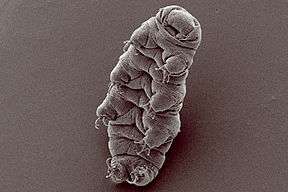List of bilateral animal orders

The relative number of species contributed to the total by each phylum of animals. Nematoda is the phylum with the most individual organisms.
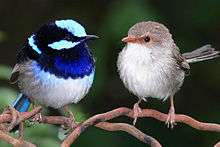
Superb fairy-wren, Malurus cyaneus
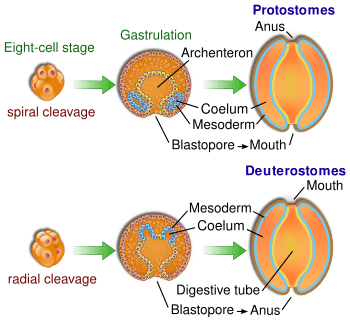
Differences between Deuterostomes and Protostomes
.jpg)
Yellow-winged darter, Sympetrum flaveolum

Pseudobiceros bedfordi, (Bedford's flatworm)
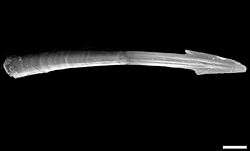
List of bilateral animal orders contains the Bilateria of the animal subkingdom Eumetazoa, divided into four superphyla, Deuterostomia, and the three Protostome superphyla, Ecdysozoa, Platyzoa and Lophotrochozoa.
| |
| |||||||||||||||||||||||||||||||||||||||||||||||||||||||||||||||||||||||||||||||||||||||||||||||||||||||||||||||||||||||||||||||||||||||||||||||||||
| |
Superphylum Deuterostomia
Phylum Chordata
Main article: List of chordate orders
Phylum Hemichordata

Acorn worm
- Class Enteropneusta (Acorn worms)
- Order Enteropneusta
- Class Graptolithina †
- Order Camaroidea †
- Order Crustoidea †
- Order Dendroidea †
- Order Dithecoidea †
- Order Graptoloidea †
- Order Stolonoidea †
- Order Tuboidea †
- Class Planctosphaeroidea
No order, one genus, one species Planctosphaera pelagica
- Class Pterobranchia
- Order Cephalodiscida
- Order Rhabdopleurida
Phylum Echinodermata
Main article: List of echinodermata orders
Phylum Xenacoelomorpha
- Family Xenoturbellidae
- Genus Xenoturbella
- Subphylum Acoelomorpha
Phylum Vetulicolia †
Banffia constricta
- Class Vetulicolida †
- Class Banffozoa †
- Family Banffidae †
- Genus Banffia †
- Class Heteromorphida †
- Class Yuyuanozoon † ?
- Genus Yuyuanozoon †
Superphylum Ecdysozoa
Phylum Kinorhyncha
No class, 2 orders, called mud dragons, very common in mud or sand
- or Cyclorhagida
- or Homalorhagida
Phylum Loricifera
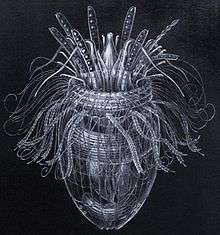
Pliciloricus enigmatus
No class, one order Nanaloricida
Phylum Priapulida

Priapulus caudatus
- Class Priapulimorpha
- Order Priapulimorphida
- Family Priapulidae
- Family Tubiluchidae
- Class Halicryptomorpha
- Order Halicryptomorphida
- Class Seticoronaria
- Order Seticoronarida
- Genus Maccabeus
Phylum Nematoda
See also: List of nematode families
Phylum Nematomorpha
- Class Gordioidea
- Class Nectonematoida
Phylum Lobopodia
- Class Dinocaridida †
- Kerygmacheloidea
- Kerygmachela
- Pambdulurion
- Anomalocaromorpha
- Parapeytoia
- Anomalocaria
- Opabiniidae
- Anomalocarida
- Pennsylvaniocaris
- Piococaris
- Sarocaris
- Paranomalocaris]]
- Anomalocarididae
- Class Xenusia †
- Order Archonychophora
- Archonychophora Hou & Bergstrom, 1995[1] - Undifferentiated appendages; each segment the same as each other. See [2]
- Luolishaniidae Hou & Bergstrom, 1995 - three small rounded sclerites per segment - these are thorn-shaped spines.[2]
- Luolishania Hou & Chen 1989
- Miraluolishania Liu & Shu 2004
- Paucipodiidae Hou et al., 2004[3] - with no dorsal sclerites, two claws, fine annulation and few segments.
- Paucipodia Hou et al. 2004
These taxa are only known from the Chengjiang (Cambrian Stage 2 Series 3).
- Order Protonychophora
- Protonychophora Hutchinson, 1930 - Spiny legs, reduced tail
- Aysheaiidae Walcott, 1911 - many claws on each leg. Anterior grasping appendages with long spines.
- Aysheaia Walcott 1911
- Xenusiidae Dzik & Krumbiegel, 1989 - >20 leg-bearing segments; paired, rounded sclerites on each segment; spiny legs.
- Xenusion Pompeckj, 1927
- Jianshanopodia Liu et al. [4] - from Chengjiang; two rows of tubercles but no obvious sclerites
- Hadranax Budd & Peel 1998 — from the Sirius Passet. Lacks obvious dorsal armature, but bears four 'nodes' per row.
- Order Scleronychophora
- Scleronychophora Hou & Bergstrom, 1995 - paired sclerites; elongated head sclerites
- Eoconchariidae Hou & Shu, 1987 - ~10 leg-bearing segments, small head, sieve-like sclerites, varying in shape along body; curved claws on annulated legs; terminal mouth and anus.
- Microdictyon Bengtson et al.
- Quadratapora Hao and Shu, 1987
- Fusuconcharium Hao and Shu, 1987
- Hallucigeniidae Conway Morris, 1977 - ~10 leg-bearing segments; large sclerites covering head; sclerites on each segment are long spines.
- Hallucigenia Conway Morris 1977 - From the Chengjiang, Kaili and Burgess Shale[5]
- Cardiodictyidae Hou & Bergstrom, 1995 - many segments (~23); large sclerites cover head; hexagonal sclerite on each body segment.
- Cardiodictyon Hou et al. 1991 - Known from the Chengjiang[5]
- Order Paronychophora
- Paronychophora Hou & Bergstrom, 1995 - short, downwards facing head; papillae on body and legs, some arranged in rows; shield-like sclerites on head; dorsal armature of spines;[6] claw-like jaws; annulated legs [ Note - diagnosis modified in [2] ]
- Onychodictyidae Hou & Bergstrom, 1995
- Onychodictyon Hou et al. 1991
- Order unassigned
- Orstenotubulus Maas et al. 2007 from the Furongian Orsten deposits - with retractable dorsal spines[7]
- Carbotubulus Haug et al. 2012 [8] - from the Mazon creek. Dorwal armature uncertain. Few segments, long limbs.
- Mureropodia,[9] from the Stage 2 Murero lagerstatten, Spain
- Class Siberion †
- Family Xenusiidae †
- Genus Siberion †
- Family Xenusiidae †
- Class Hadranax †
- Order Protonychophora †
- Family Xenusiidae †
- Genus Hadranax †
- Family Xenusiidae †
- Order Archonychophora Hou & Bergstrom, 1995[1] - Undifferentiated appendages; each segment the same as each other. See [2]
- Luolishaniidae Hou & Bergstrom, 1995 - three small rounded sclerites per segment - these are thorn-shaped spines.[2]
- Luolishania Hou & Chen 1989
- Miraluolishania Liu & Shu 2004
- Paucipodiidae Hou et al., 2004[3] - with no dorsal sclerites, two claws, fine annulation and few segments.
- Paucipodia Hou et al. 2004
- Luolishaniidae Hou & Bergstrom, 1995 - three small rounded sclerites per segment - these are thorn-shaped spines.[2]
- Order Protonychophora Hutchinson, 1930 - Spiny legs, reduced tail
- Order Scleronychophora Hou & Bergstrom, 1995 - paired sclerites; elongated head sclerites
- Eoconchariidae Hou & Shu, 1987 - ~10 leg-bearing segments, small head, sieve-like sclerites, varying in shape along body; curved claws on annulated legs; terminal mouth and anus.
- Microdictyon Bengtson et al.
- Quadratapora Hao and Shu, 1987
- Fusuconcharium Hao and Shu, 1987
- Hallucigeniidae Conway Morris, 1977 - ~10 leg-bearing segments; large sclerites covering head; sclerites on each segment are long spines.
- Hallucigenia Conway Morris 1977 - From the Chengjiang, Kaili and Burgess Shale[5]
- Cardiodictyidae Hou & Bergstrom, 1995 - many segments (~23); large sclerites cover head; hexagonal sclerite on each body segment.
- Cardiodictyon Hou et al. 1991 - Known from the Chengjiang[5]
- Eoconchariidae Hou & Shu, 1987 - ~10 leg-bearing segments, small head, sieve-like sclerites, varying in shape along body; curved claws on annulated legs; terminal mouth and anus.
- Order Paronychophora Hou & Bergstrom, 1995 - short, downwards facing head; papillae on body and legs, some arranged in rows; shield-like sclerites on head; dorsal armature of spines;[6] claw-like jaws; annulated legs [ Note - diagnosis modified in [2] ]
- Onychodictyidae Hou & Bergstrom, 1995
- Onychodictyon Hou et al. 1991
- Onychodictyidae Hou & Bergstrom, 1995
- Order unassigned
- Orstenotubulus Maas et al. 2007 from the Furongian Orsten deposits - with retractable dorsal spines[7]
- Carbotubulus Haug et al. 2012 [8] - from the Mazon creek. Dorwal armature uncertain. Few segments, long limbs.
- Mureropodia,[9] from the Stage 2 Murero lagerstatten, Spain
Phylum Onychophora
- Order Euonychophora
- Family Peripatidae
- Family Peripatopsidae
- Order Ontonychophora †
- Family Helenodoridae †
- Family Tertiapatoidea †
Phylum Tardigrada

Echiniscus
- Class Eutardigrada
- Order Apochela
- Family Milnesiidae
- Order Parachaela
- Family Beornidae
- Family Calohypsibiidae
- Family Eohypsibiidae
- Family Hypsibiidae
- Family Macrobiotidae
- Family Microhypsibiidae
- Family Necopinatidae
- Class Heterotardigrada
- Order Arthrotardigrada
- Family Archechiniscidae
- Family Batillipedidae
- Family Coronarctidae
- Family Halechiniscidae
- Family Renaudarctidae
- Family Stygarctidae
- Order Echiniscoidea
- Family Echiniscidae
- Family Echiniscoididae
- Family Oreellidae
- Class Mesotardigrada
- Order Thermozodia
- Family Thermozodiidae
- Genus Thermozodium
- Family Thermozodiidae
Phylum Arthropoda
Main article: List of arthropod orders
Superphylum Platyzoa
Phylum Platyhelminthes (flatworms)
- Class Cestoda
- Subclass Cestodaria
- Order Amphilinidea
- Order Gyrocotylidea
- Subclass Eucestoda
- Order Aporidea
- Order Caryophyllidea
- Order Cyclophyllidea
- Order Diphyllidea
- Order Lecanicephalidea
- Order Litobothridea
- Order Nippotaeniidea
- Order Proteocephalidea
- Order Pseudophyllidea
- Order Spathebothriidea
- Order Tetraphyllidea
- Order Trypanorhyncha
- Class Monogenea
- Subclass Monopisthocotylea
- Order Capsalidea
- Order Dactylogyridea
- Order Gyrodactylidea
- Order Monocotylidea
- Order Montchadskyellidea
- Subclass Polyopisthocotylea
- Order Chimaericolidea
- Order Diclybothriidea
- Order Mazocraeidea
- Order Polystomatidea
- Class Trematoda

Botulus microporus
- Subclass Aspidogastrea
- Family Aspidogastridae
- Family Multicalycidae
- Family Rugogastridae
- Family Stichocotylidae
- Subclass Digenea

Helicometra
- Order Azygiida
- Order Echinostomida
- Order Opisthorchiida
- Order Plagiorchiida
- Order Strigeidida
- Class Turbellaria
- Order Catenulida
- Order Haplopharyngida
- Order Lecithoepitheliata
- Order Macrostomida
- Order Nemertodermata
- Order Polycladida
- Order Prolecithophora
- Order Rhabdocoela
- Order Seriata
- Order Temnocephalida
- Order Tricladida
Phylum Gastrotricha
No classes
- Order Chaetonotida
- Order Macrodasyida
Phylum Rotifera
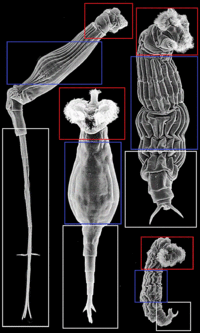
SEM] pictures of some Bdelloidea species of the genus Rotaria with head (red), tail (white) and trunk (blue) areas highlighted
- Class Bdelloidea
- Order Bdelloida
- Class Monogononta
- Order Collothecida
- Order Flosculariida
- Order Ploimida
- Class Seisonidea
- Order Seisonida
Phylum Acanthocephala

Scanning electron microscopy of proboscis of an archiacanthocephalan [10]
- Class Archiacanthocephala
- Order Apororhynchida
- Order Gigantorhynchida
- Order Moniliformida
- Order Oligacanthorhynchida
- Class Eoacanthocephala
- Order Gyracanthocephala
- Order Neoechinorhynchida
- Class Palaeacanthocephala
- Order Echinorhynchida
- Order Polymorphida
Phylum Gnathostomulida
No classes
- Order Bursovaginoidea
- Order Filospermoidea
Phylum Micrognathozoa
Some dispute here with Micrognathozoa as the class and Limnognathia as the order
Phylum Cycliophora
This phylum was discovered in 1995.
- Class Symbiida
- Order Symbiidae
- Genus Symbion
Superphylum Lophotrochozoa
Phylum Sipuncula
- Class Phascolosomatidea
- Order Aspidosiphoniformes
- Family Aspidosiphonidae
- Order Phascolosomatiformes
- Family Phascolosomatidae
- Class Sipunculidea
- Order Golfingiiformes
- Family Golfingiidae
- Family Phascolionidae
- Family Themistidae
- Order Sipunculiformes
- Family Sipunculidae
Phylum Nemertea
- Class Anopla
- Order Heteronemertea
- Order Palaeonemertea
- Class Enopla
- Order Bdellonemertea
- Order Hoplonemertea
Phylum Phoronida
- Class Phoronid
Phylum Bryozoa
- Class Gymnolaemata
- subclass Cheilostomata
- subclass Ctenostomata
- Class Phylactolaemata
- subclass Plumatellida
- Class Stenolaemata
- subclass Cryptostomida †
- subclass Cyclostomatida
- subclass Cystoporida †
- subclass Fenestrida †
- subclass Hederellida †
- subclass Trepostomatida †
Phylum Entoprocta
No classes, no orders, families Barentsiidae, Loxokalypodidae, Loxosomatidae, Pedicellinidae
Phylum Brachiopoda
- Class Lingulata
- Class Craniata/Craniforma
- Order Craniida
- Class Rhynchonellata
- Order Terebratulida
- Order Rhynchonellida
Phylum Mollusca
Main article: List of mollusc orders
Phylum Annelida
Main article: List of Annelid families
References
- 1 2 Hou, X.; Bergström, J. A. N. (1995). "Cambrian lobopodians-ancestors of extant onychophorans?". Zoological Journal of the Linnean Society. 114: 3. doi:10.1111/j.1096-3642.1995.tb00110.x.
- 1 2 3 4 5 6 Ma, X.; Hou, X.; Bergström, J. (2009). "Morphology of Luolishania longicruris (Lower Cambrian, Chengjiang Lagerstätte, SW China) and the phylogenetic relationships within lobopodians". Arthropod Structure & Development. 38 (4): 271. doi:10.1016/j.asd.2009.03.001.
- 1 2 Xian-Guang Hou, Xiao-Ya Ma, Jie Zhao & Jan Bergström; Ma; Zhao; Bergström (2004). "The lobopodian Paucipodia inermis from the Lower Cambrian Chengjiang fauna, Yunnan, China". Lethaia. 37 (3): 235–244. doi:10.1080/00241160410006555.
- ↑ Jianni Liu; Degan Shu; Jian Han; Zhifei Zhang & Xingliang Zhang (2006). "A large xenusiid lobopod with complex appendages from the Lower Cambrian Chengjiang Lagerstätte" (PDF). Acta Palaeontol. Pol. 51 (2): 215–222. Retrieved 9 February 2011.
- 1 2 3 4 Whittle, R. J.; Gabbott, S. E.; Aldridge, R. J.; Theron, J. (2009). "An Ordovician Lobopodian from the Soom Shale Lagerstätte, South Africa". Palaeontology. 52 (3): 561–567. doi:10.1111/j.1475-4983.2009.00860.x.
- 1 2 Liu, J.; Shu, D.; Han, J.; Zhang, Z.; Zhang, X. (2008). "The LobopodOnychodictyonfrom the Lower Cambrian Chengjiang Lagerstätte Revisited". Acta Palaeontologica Polonica. 53 (2): 285. doi:10.4202/app.2008.0209.
- 1 2 Maas, A.; Mayer, G.; Kristensen, R. M.; Waloszek, D. (2007). "A Cambrian micro-lobopodian and the evolution of arthropod locomotion and reproduction". Chinese Science Bulletin. 52 (24): 3385. doi:10.1007/s11434-007-0515-3.
- 1 2 Haug, J. T.; Mayer, G.; Haug, C.; Briggs, D. E. G. (2012). "A Carboniferous Non-Onychophoran Lobopodian Reveals Long-Term Survival of a Cambrian Morphotype". Current Biology. doi:10.1016/j.cub.2012.06.066.
- 1 2 Gámez Vintaned, J. A.; Liñán, E.; Zhuravlev, A. (2011). "A New Early Cambrian Lobopod-Bearing Animal (Murero, Spain) and the Problem of the Ecdysozoan Early Diversification". Evolutionary Biology – Concepts, Biodiversity, Macroevolution and Genome Evolution. p. 193. doi:10.1007/978-3-642-20763-1_12. ISBN 978-3-642-20762-4.
- ↑ Amin, O. A, Heckmann, R. A & Ha, N. V. (2014) Acanthocephalans from fishes and amphibians in Vietnam, with descriptions of five new species. Parasite, 21, 53 doi:10.1051/parasite/2014052PMID 25331738

This article is issued from Wikipedia - version of the 11/27/2016. The text is available under the Creative Commons Attribution/Share Alike but additional terms may apply for the media files.

